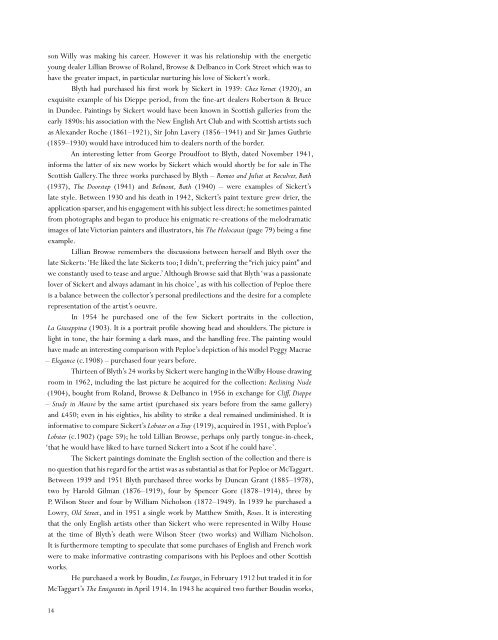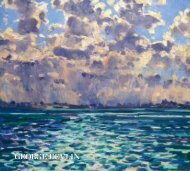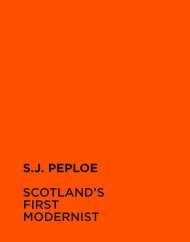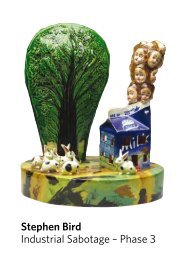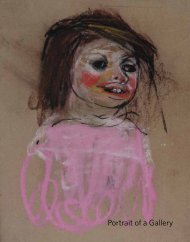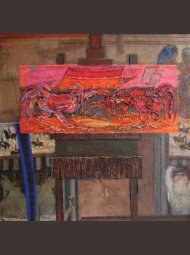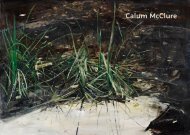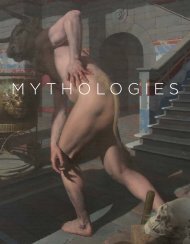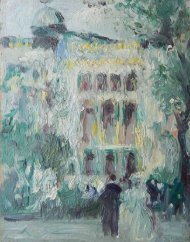Download a PDF of the exhibition catalogue - The Scottish Gallery
Download a PDF of the exhibition catalogue - The Scottish Gallery
Download a PDF of the exhibition catalogue - The Scottish Gallery
You also want an ePaper? Increase the reach of your titles
YUMPU automatically turns print PDFs into web optimized ePapers that Google loves.
son Willy was making his career. However it was his relationship with <strong>the</strong> energetic<br />
young dealer Lillian Browse <strong>of</strong> Roland, Browse & Delbanco in Cork Street which was to<br />
have <strong>the</strong> greater impact, in particular nurturing his love <strong>of</strong> Sickert’s work.<br />
Blyth had purchased his first work by Sickert in 1939: Chez Vernet (1920), an<br />
exquisite example <strong>of</strong> his Dieppe period, from <strong>the</strong> fine-art dealers Robertson & Bruce<br />
in Dundee. Paintings by Sickert would have been known in <strong>Scottish</strong> galleries from <strong>the</strong><br />
early 1890s: his association with <strong>the</strong> New English Art Club and with <strong>Scottish</strong> artists such<br />
as Alexander Roche (1861–1921), Sir John Lavery (1856–1941) and Sir James Guthrie<br />
(1859–1930) would have introduced him to dealers north <strong>of</strong> <strong>the</strong> border.<br />
An interesting letter from George Proudfoot to Blyth, dated November 1941,<br />
informs <strong>the</strong> latter <strong>of</strong> six new works by Sickert which would shortly be for sale in <strong>The</strong><br />
<strong>Scottish</strong> <strong>Gallery</strong>. <strong>The</strong> three works purchased by Blyth – Romeo and Juliet at Reculver, Bath<br />
(1937), <strong>The</strong> Doorstep (1941) and Belmont, Bath (1940) – were examples <strong>of</strong> Sickert’s<br />
late style. Between 1930 and his death in 1942, Sickert’s paint texture grew drier, <strong>the</strong><br />
application sparser, and his engagement with his subject less direct: he sometimes painted<br />
from photographs and began to produce his enigmatic re-creations <strong>of</strong> <strong>the</strong> melodramatic<br />
images <strong>of</strong> late Victorian painters and illustrators, his <strong>The</strong> Holocaust (page 79) being a fine<br />
example.<br />
Lillian Browse remembers <strong>the</strong> discussions between herself and Blyth over <strong>the</strong><br />
late Sickerts: ‘He liked <strong>the</strong> late Sickerts too; I didn’t, preferring <strong>the</strong> “rich juicy paint” and<br />
we constantly used to tease and argue.’ Although Browse said that Blyth ‘was a passionate<br />
lover <strong>of</strong> Sickert and always adamant in his choice’, as with his collection <strong>of</strong> Peploe <strong>the</strong>re<br />
is a balance between <strong>the</strong> collector’s personal predilections and <strong>the</strong> desire for a complete<br />
representation <strong>of</strong> <strong>the</strong> artist’s oeuvre.<br />
In 1954 he purchased one <strong>of</strong> <strong>the</strong> few Sickert portraits in <strong>the</strong> collection,<br />
La Giuseppina (1903). It is a portrait pr<strong>of</strong>ile showing head and shoulders. <strong>The</strong> picture is<br />
light in tone, <strong>the</strong> hair forming a dark mass, and <strong>the</strong> handling free. <strong>The</strong> painting would<br />
have made an interesting comparison with Peploe’s depiction <strong>of</strong> his model Peggy Macrae<br />
– Elegance (c.1908) – purchased four years before.<br />
Thirteen <strong>of</strong> Blyth’s 24 works by Sickert were hanging in <strong>the</strong> Wilby House drawing<br />
room in 1962, including <strong>the</strong> last picture he acquired for <strong>the</strong> collection: Reclining Nude<br />
(1904), bought from Roland, Browse & Delbanco in 1956 in exchange for Cliff, Dieppe<br />
– Study in Mauve by <strong>the</strong> same artist (purchased six years before from <strong>the</strong> same gallery)<br />
and £450; even in his eighties, his ability to strike a deal remained undiminished. It is<br />
informative to compare Sickert’s Lobster on a Tray (1919), acquired in 1951, with Peploe’s<br />
Lobster (c.1902) (page 59); he told Lillian Browse, perhaps only partly tongue-in-cheek,<br />
‘that he would have liked to have turned Sickert into a Scot if he could have’.<br />
<strong>The</strong> Sickert paintings dominate <strong>the</strong> English section <strong>of</strong> <strong>the</strong> collection and <strong>the</strong>re is<br />
no question that his regard for <strong>the</strong> artist was as substantial as that for Peploe or McTaggart.<br />
Between 1939 and 1951 Blyth purchased three works by Duncan Grant (1885–1978),<br />
two by Harold Gilman (1876–1919), four by Spencer Gore (1878–1914), three by<br />
P. Wilson Steer and four by William Nicholson (1872–1949). In 1939 he purchased a<br />
Lowry, Old Street, and in 1951 a single work by Mat<strong>the</strong>w Smith, Roses. It is interesting<br />
that <strong>the</strong> only English artists o<strong>the</strong>r than Sickert who were represented in Wilby House<br />
at <strong>the</strong> time <strong>of</strong> Blyth’s death were Wilson Steer (two works) and William Nicholson.<br />
It is fur<strong>the</strong>rmore tempting to speculate that some purchases <strong>of</strong> English and French work<br />
were to make informative contrasting comparisons with his Peploes and o<strong>the</strong>r <strong>Scottish</strong><br />
works.<br />
He purchased a work by Boudin, Les Fourges, in February 1912 but traded it in for<br />
McTaggart’s <strong>The</strong> Emigrants in April 1914. In 1943 he acquired two fur<strong>the</strong>r Boudin works,<br />
14


